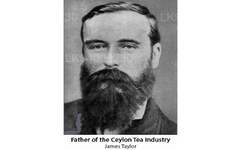James Taylor
James Taylor is the father of Sri Lanka’s prolific tea industry. Born on the 29th of May 1835 in Kincardineshire, Scotland; Taylor was an enterprising British individual migrated to the tropical paradise of Sri Lanka in 1852. He settled down in the lands that are now known as the Loolecondera Estate. Ceylon was concentrating on coffee plantation at the time; until the trees were struck with a disease known as coffee rust or the rust blight.
Shocked by the outcome, James Taylor and the other migrant British began looking at alternatives. Unable to find any possible options from his chilly homeland of Britain, that would fit the tropical climes of Ceylon; James decided to visit the nearby India instead. Tea was just starting to take off in India at the time; and he had heard rumors of this miracle plant that gave the most divine and best loved drink of the British. Tea had been imported from Eastern countries such as China up until that point; and therefore, was very expensive. When James Taylor arrived in India in 1866, tea was still a budding industry. Taylor learnt all the modern techniques available at the time and returned to Sri Lanka.
The First Tea Plantation
Sri Lanka’s first tea plantation began in 1967 on an estate of just 19 acres (77000 m2), and was named the Loolecondera Estate by James Taylor. He created the estate by clearing the necessary area of forest in the district of Hewaheta Lower. James’ studies in India had shown him that this area was the perfect environment for growing tea. The first seedlings were planted in what is now Field No 7 in the Loolecondera Estate. Taylor’s assumptions were correct as the trees flourished; and in 1972, he personally attended the building of a large tea factory according to his specifications. Many of the machines were creations of Taylor himself, in order to speed up the process of tea manufacture and to maintain its quality. This was recorded by James Taylor himself as he wrote "I have a machine of my own invention being made in Kandy for rolling tea which I think will be successful".
Shortly after construction the factory started manufacturing packeted tea. In 1875, the trademark of Ceylon Tea began its life with the very first shipment of tea that was sent to the London Tea Auction. It was very successful and many tea estates started to be created all over Ceylon. During the period when Taylor lived on the Loolecondera estate, the export of tea from Ceylon accelerated from 23 pounds to 81 tonnes; and in 1890 it reached the level of 22,900 tonnes.
Taylor meets Lipton
In the early 1890s larger tea companies started taking over the smaller tea farmers in Ceylon, such as James Taylor. So Taylor had to come up with a way to up his game. That was when he met Lipton purely by chance. Sir Thomas Johnstone Lipton was a millionaire from the United Kingdom, who stopped by Ceylon on his visit to Australia. Lipton was impressed by Taylor’s knowledge of tea and his entrepreneurship; not to mention that this was the man who made the first tea shipment from Ceylon. Lipton’s company became interested in the profitability of exporting Ceylon tea, and soon started purchasing it .
The end of James Taylor
Despite his attempts to keep his head above the deepening waters of the Ceylon Tea industry; James Taylor was not able to escape the sharks that were the larger companies. The management of Loolecondera estate was slowly taken over by one of the larger competitors. Taylor was dismissed from his own estate by the management of Loolecondera. It was a harsh blow for him as he was the pioneer of tea in Ceylon. Taylor’s health suffered; and in 1892, an year after his dismissal, James Taylor died from severe gastroenteritis and dysentry.
His body was buried in the Mahaiyawa Cemetery in Kandy. On his grave’s headstone a message was carved saying, "In pious memory of James Taylor of Loolecondera Estate Ceylon, the pioneer of the cinchona and tea enterprise in this island, who died May 2, 1892, aged 57 years".
In 1893, one year after his death, one million packets of Ceylon tea from Taylor’s very first shipment to London were sold at the Chicago World’s Fair at an exorbitant price.
The Ceylon Tea Industry after Taylor’s death
The Ceylon Tea industry continued to grow after Taylor’s death. During this time the majority of the tea estates of Ceylon were owned and managed by the British. This trend continued until 1971, when the government of Sri Lanka introduced a Land Reform Act which granted the ownership of tea estates to the government; causing a nationalisation of the tea industry.
IN 1992 a century after the death of James Taylor; the British had nothing to do with Ceylon’s tea estates, at least directly. The sacrifices and hard work of James Taylor, however, had been brought to light. A museum was built in Ceylon that year to commemorate him in the place that he lived. John Field, the High Commissioner for the United Kingdom in Sri Lanka made a comment that year for the 100th death anniversary of Taylor:
"It can be said of very few individuals that their labours have helped to shape the landscape of a country, but the beauty of the hill country as it now appears owes much to the inspiration of James Taylor, the man who introduced tea cultivation to Sri Lanka"







